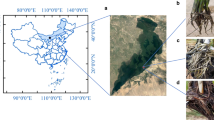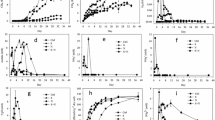Abstract
Methanogenic archaea survive under aerated soil conditions in paddy fields, and their community is stable under these conditions. Changes in the abundance and composition of an active community of methanogenic archaea were assessed by analyzing mcrA gene (encoding α subunit of methyl-coenzyme M reductase) and transcripts during a prolonged drained period in a paddy-upland rotational field. Paddy rice (Oryza sativa L.) was planted in the flooded field and rotated with soybean (Glycine max [L.] Merr.) under upland soil conditions. Soil samples were collected from the rotational plot in the first year, with paddy rice, and in the two successive years, with soybean, at six time points, before seeding, during cultivation, and after harvest as well as from a consecutive paddy (control) plot. By the time that soybean was grown in the second year, the methanogenic archaeal community in the rotational plot maintained high mcrA transcript levels, comparable with those of the control plot community, but the levels drastically decreased by over three orders of magnitude after 2 years of upland conversion. The composition of active methanogenic archaeal communities that survived upland conversion in the rotational plot was similar to that of the active community in the control plot. These results revealed that mcrA gene transcription of methanogenic archaeal community in the rotational field was affected by a prolonged non-flooding period, longer than 1 year, indicating that unknown mechanisms maintain the stability of methanogenic archaeal community in paddy fields last up to 1 year after the onset of drainage.





Similar content being viewed by others
References
Ciais P, Sabine C, Bala G, Bopp L, Brovkin V, Canadell J, Chhabra A, DeFries R, Galloway J, Heimann M, Jones C, Le Quéré C, Myneni RB, Piao S, Thornton P (2013) Carbon and other biogeochemical cycles. In: Stocker TF, Qin D, Plattner GK, Tignor M, Allen SK, Boschung J, Nauels A, Xia Y, Bex V, Midgley PM (eds) Climate change 2013: the physical science basis. Contribution of Working Group I to the Fifth Assessment Report of the Intergovernmental Panel on Climate Change. Cambridge University Press, Cambridge, pp. 465–570
Thauer RK, Kaster AK, Seedorf H, Buckel W, Hedderich R (2008) Methanogenic archaea: ecologically relevant differences in energy conservation. Nat Rev Microbiol 6:579–591
Conrad R (2007) Microbial ecology of methanogens and methanotrophs. Adv. Agron. 96:1–63
Watanabe T, Kimura M, Asakawa S (2006) Community structure of methanogenic archaea in paddy field soil under double cropping (rice-wheat). Soil Biol. Biochem. 38:1264–1274
Asakawa S, Hayano K (1995) Populations of methanogenic bacteria in paddy field soil under double cropping conditions (rice-wheat). Biol. Fertil. Soils 20:113–117
Asakawa S, Akagawa-Matsushita M, Koga Y, Hayano K (1998) Communities of methanogenic bacteria in paddy field soils with long-term application of organic matter. Soil Biol. Biochem. 30:299–303
Watanabe T, Kimura M, Asakawa S (2007) Dynamics of methanogenic archaeal communities based on rRNA analysis and their relation to methanogenic activity in Japanese paddy field soils. Soil Biol. Biochem. 39:2877–2887
Watanabe T, Kimura M, Asakawa S (2009) Distinct members of a stable methanogenic archaeal community transcribe mcrA genes under flooded and drained conditions in Japanese paddy field soil. Soil Biol. Biochem. 41:276–285
Liu D, Ishikawa H, Nishida M, Tsuchiya K, Takahashi T, Kimura M, Asakawa S (2015) Effect of paddy-upland rotation on methanogenic archaeal community structure in paddy field soil. Microb. Ecol. 69:160–168
Scavino AF, Ji Y, Pump J, Klose M, Claus P, Conrad R (2013) Structure and function of the methanogenic microbial communities in Uruguayan soils shifted between pasture and irrigated rice fields. Environ. Microbiol. 15:2588–2602
Lee HJ, Kim SY, Kim PJ, Madsen EL, Jeon CO (2014) Methane emission and dynamics of methanotrophic and methanogenic communities in a flooded rice field ecosystem. FEMS Microbiol. Ecol. 88:195–212
Breidenbach B, Conrad R (2014) Seasonal dynamics of bacterial and archaeal methanogenic communities in flooded rice fields and effect of drainage. Front. Microbiol. 5:752–752
Breidenbach B, Blaser MB, Klose M, Conrad R (2016) Crop rotation of flooded rice with upland maize impacts the resident and active methanogenic microbial community. Environ. Microbiol. 18:2868–2885
Yuan Y, Conrad R, Lu Y (2011) Transcriptional response of methanogen mcrA genes to oxygen exposure of rice field soil. Environ. Microbiol. Rep. 3:320–328
Ma K, Conrad R, Lu Y (2012) Responses of methanogen mcrA genes and their transcripts to an alternate dry/wet cycle of paddy field soil. Appl. Environ. Microbiol. 78:445–454
Bridgham SD, Cadillo-Quiroz H, Keller JK, Zhuang Q (2013) Methane emissions from wetlands: biogeochemical, microbial, and modeling perspectives from local to global scales. Glob Change Biol 19:1325–1346
Shirato Y, Yagasaki Y, Nishida M (2011) Using different versions of the rothamsted carbon model to simulate soil carbon in long-term experimental plots subjected to paddy–upland rotation in Japan. Soil Sci. Plant Nutr. 57:597–606
Lueders T, Manefield M, Friedrich MW (2004) Enhanced sensitivity of DNA- and rRNA-based stable isotope probing by fractionation and quantitative analysis of isopycnic centrifugation gradients. Environ. Microbiol. 6:73–78
Murase J, Hida A, Ogawa K, Nonoyama T, Yoshikawa N, Imai K (2015) Impact of long-term fertilizer treatment on the microeukaryotic community structure of a rice field soil. Soil Biol. Biochem. 80:237–243
Luton PE, Wayne JM, Sharp RJ, Riley PW (2002) The mcrA gene as an alternative to 16S rRNA in the phylogenetic analysis of methanogen populations in landfill. Microbiology 148:3521–3530
Liu D, Suekuni C, Akita K, Ito T, Saito M, Watanabe T, Kimura M, Asakawa S (2012) Effect of winter-flooding on methanogenic archaeal community structure in paddy field under organic farming. Soil Sci. Plant Nutr. 58:553–561
Watanabe T, Wang G, Taki K, Ohashi Y, Kimura M, Asakawa S (2010) Vertical changes in bacterial and archaeal communities with soil depth in Japanese paddy fields. Soil Sci. Plant Nutr. 56:705–715
Egert M, Friedrich MW (2005) Post-amplification Klenow fragment treatment alleviates PCR bias caused by partially single-stranded amplicons. J Microbiol Meth 61:69–75
Barbier BA, Dziduch I, Liebner S, Ganzert L, Lantuit H, Pollard W, Wagner D (2012) Methane-cycling communities in a permafrost-affected soil on Herschel Island, Western Canadian Arctic: active layer profiling of mcrA and pmoA genes. FEMS Microbiol. Ecol. 82:287–302
Schloss PD, Westcott SL, Ryabin T, Hall JR, Hartmann M, Hollister EB, Lesniewski RA, Oakley BB, Parks DH, Robinson CJ, Sahl JW, Stres B, Thallinger GG, Van Horn DJ, Weber CF (2009) Introducing mothur: open-source, platform-independent, community-supported software for describing and comparing microbial communities. Appl. Environ. Microbiol. 75:7537–7541
Tamura K, Stecher G, Peterson D, Filipski A, Kumar S (2013) MEGA6: molecular evolutionary genetics analysis version 6.0. Mol. Biol. Evol. 30:2725–2729
Hammer Ø, Harper DAT, Ryan P D (2001) Paleontological statistics software: package for education and data analysis. Palaeontol Electron 4:1–9
Lever MA, Rogers KL, Lloyd KG, Overmann J, Schink B, Thauer RK, Hoehler TM, Jorgensen BB (2015) Life under extreme energy limitation: a synthesis of laboratory- and field-based investigations. FEMS Microbiol. Rev. 39:688–728
Shima S, Sordel-Klippert M, Brioukhanov A, Netrusov A, Linder D, Thauer RK (2001) Characterization of a heme-dependent catalase from Methanobrevibacter arboriphilus. Appl Environ Microbiol 67:3041–3045
Brioukhanov AL, Thauer RK, Netrusov AI (2002) Catalase and superoxide dismutase in the cells of strictly anaerobic microorganisms. Microbiology 71:281–285
Fetzer S, Bak F, Conrad R (1993) Sensitivity of methanogenic bacteria from paddy soil to oxygen and desiccation. FEMS Microbiol Ecol 12:107–115
Miyaki T, Oyaizu H, Matsumoto S (1996) Methanogenesis from dried and heat treated paddy soil. Microbes Environ 11:51–55
Greening C, Biswas A, Carere CR, Jackson CJ, Taylor MC, Stott MB, Cook GM, Morales SE (2016) Genomic and metagenomic surveys of hydrogenase distribution indicate H2 is a widely utilised energy source for microbial growth and survival. ISME J 10:761–777
Conrad R, Seiler W (1980) Contribution of hydrogen production by biological nitrogen fixation to the global hydrogen budget. J Geophys Res 85:5493–5498
von Fischer JC, Hedin LO (2002) Separating methane production and consumption with a field-based isotope pool dilution technique. Global Biogeochem Cycles 16:8–13
Megonigal JP, Guenther AB (2008) Methane emissions from upland forest soils and vegetation. Tree Physiol 28:491–498
Kusel K, Drake HL (1995) Effects of environmental parameters on the formation and turnover of acetate by forest soils. Appl Environ Microbiol 61:3667–3675
Degelmann DM, Kolb S, Dumont M, Murrell JC, Drake HL (2009) Enterobacteriaceae facilitate the anaerobic degradation of glucose by a forest soil. FEMS Microbiol Ecol 68:312–319
DeAngelis KM, Allgaier M, Chavarria Y, Fortney JL, Hugenholtz P, Simmons B, Sublette K, Silver WL, Hazen TC (2011) Characterization of trapped lignin-degrading microbes in tropical forest soil. PLoS One 6: e19306
Anderson KL, Apolinario EE, Sowers KR (2012) Desiccation as a long-term survival mechanism for the archaeon Methanosarcina barkeri. Appl Environ Microbiol 78:1473–1479
Xie W, Jiao N, Ma CL, Fang S, Phelps JT, Zhu RX, Zhang CL (2017) The response of archaeal species to seasonal variables in a subtropical aerated soil: insight into the low abundant methanogens. Appl Microbiol Biotechnol 101:6505–6515
Tong C, Cadillo-Quiroz H, Zeng ZH, She CX, Yang P, Huang JF (2017) Changes of community structure and abundance of methanogens in soils along a freshwater–brackish water gradient in subtropical estuarine marshes. Geoderma 299:101–110
Kumagai K, Konno Y (1998) Methane emission from rice paddy fields after upland farming. Jpn J Soil Sci Plant Nutr 69: 333–339 (in Japanese with English summary)
Eusufzai MK, Tokida T, Okada M, Sugiyama S, Liu GC, Nakajima M, Sameshima R (2010) Methane emission from rice fields as affected by land use change. Agr Ecosyst Environ 139:742–748
Shiono H, Saito H, Nakagawa F, Kumagai K (2014) Effects of crop rotation and rice straw incorporation in spring on methane and nitrous oxide emissions from an upland paddy field in a cold region of Japan. Jpn J Soil Sci Plant Nutr 85:420–430 (in Japanese with English summary)
Acknowledgements
We thank Professor Emeritus Makoto Kimura from the Graduate School of Bioagricultural Sciences, Nagoya University, for his helpful suggestions and comments.
Funding Information
This work was supported in part by the Environmental Research Projects from the Sumitomo Foundation [Grant number: 143218] and by the Soil e-DNA Project from the Ministry of Agriculture, Forestry, and Fisheries of Japan [Grant number: eDNA-07-101-1].
Author information
Authors and Affiliations
Corresponding author
Additional information
Accession number: Sequences of mcrA genes and transcripts from methanogenic archaea obtained in the course of the present study have been deposited in GenBank/EMBL/DDBJ under accession numbers LC154114-LC154792.
Electronic Supplementary Material
Supplemental Fig. S1
(PPTX 177 kb)
Supplemental Fig. S2
(PPTX 219 kb)
Supplemental Fig. S3
(PPTX 404 kb)
Supplemental Table 1
(DOCX 20 kb)
Supplemental Table 2
(DOCX 24 kb)
Rights and permissions
About this article
Cite this article
Liu, D., Nishida, M., Takahashi, T. et al. Transcription of mcrA Gene Decreases Upon Prolonged Non-flooding Period in a Methanogenic Archaeal Community of a Paddy-Upland Rotational Field Soil. Microb Ecol 75, 751–760 (2018). https://doi.org/10.1007/s00248-017-1063-2
Received:
Accepted:
Published:
Issue Date:
DOI: https://doi.org/10.1007/s00248-017-1063-2




